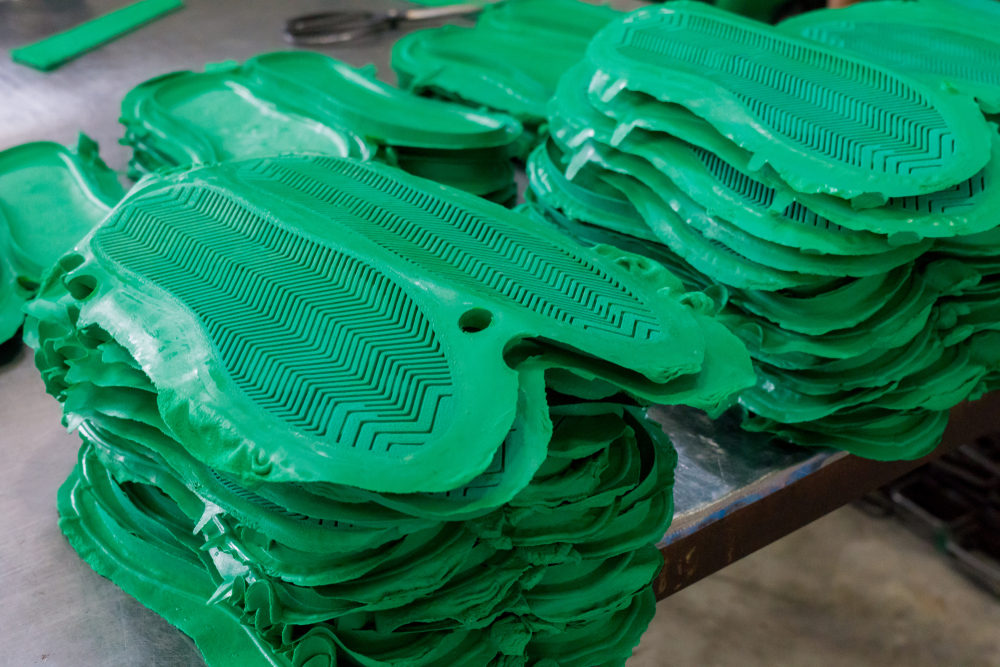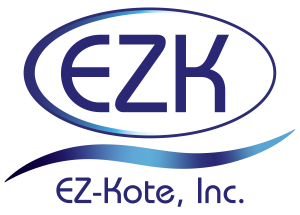
Mold releases for shoe sole manufacturing work for a wide range of processes at your factory. Our chemical engineers have been working on first-class mold releases since the mid-1980s, a full decade before most major manufacturers of mold releases.
See answers to frequently asked questions regarding our shoe sole mold releases.
What processes do shoe sole mold releases work for?
Our water-based mold releases work for single-density casting, dual-density casting, and direct attach/injection molding for polyurethane integral skin.
Shoe sole mold releases for single-density casting usually have a mold release that manufacturers recommend you apply every cycle. However, when this happens, you have build-up occurring in the mold. EZ-Kote’s products prevent this while helping your molds last longer and requiring less maintenance.
Dual-density sole casting involves making the outsole and midsole in the same cast. Our water-based mold release formulas allow for clean releases from all parts of the mold when you need to maintain the correct shape.
Related Post: Molding & Casting FAQs
Injection molding requires a delicate balance among surface adhesion, slip, and flow. EZ-Kote’s water-based mold releases are durable while creating the right slip coefficients for your delicate injection molding processes.
For direct attaching, the right shoe sole mold releases reduce scrap and alleviate concerns of ejection rates. If the sole does not release properly, the upper shoe is also wasted, and you have way too much scrap on your hands.
What materials can shoe sole mold releases work with?
Shoe sole mold release technology must stay at the forefront of manufacturers who always research and find new materials for shoe soles that increase durability, decrease weight, and improve shock absorption for their products. New materials may not always work with the same-old mold release agents.
EZ-Kote’s water-based mold releases can work with many types of materials, including:
- Acrylonitrile butadiene styrene (ABS)
- Bio-based polyurethane
- Ethyl vinyl acetate (EVA)
- Polyurethane
- Polyester systems
- Polyether PU systems
- PVC
- Natural rubber
- Synthetic rubber
- Thermoplastic rubber (TRP)
If you have a new, advanced substance you’re making into shoe soles, talk to the chemical engineers at EZ-Kote. We can make a custom formulation to suit your needs.
Why should I use a water-based shoe sole mold release?
Water-based shoe sole mold releases create cleaner SKUs, produce less scrap, and have improved slip and improve line efficiency.
Cleaner SKUs: Your products will have fewer defects over the course of a production run, giving you a higher-quality product to send to your customers.
Produce less scrap: Cleaner SKUs for shoe soles produce less scrap. Once your rubber sole is in place in the mold, it is very difficult or impossible to reuse for another batch, depending on your processes and products. It may have to be ground down to fine particles for recycling rather than being made into another shoe sole. Polyurethane-based waste (PUW) can be used as a reinforcing filler for natural rubber. However, that isn’t the most efficient use of your end product because you have to send it to a specialty manufacturer or grind it into a fine powder yourself.
Improved slip: You need some slip on your molds, and your mold release should have the exact slip you expect. Using the wrong shoe sole release can cause the wrong slip on your products, causing more scrap and more defective SKUs.
Related Post: Rubber Anti-Tack Agent FAQs
Who can help me choose the proper shoe sole mold release?
EZ-Kote has more than 30 years of experience with water-based mold releases. Our engineers can help you select and test the right one for your shoe soles based on your requirements.
Have a new material? We can produce a custom formulation for you to test.
Contact EZ-Kote or call (770) 720-1811 for more details. We’ll respond within 24 hours.
